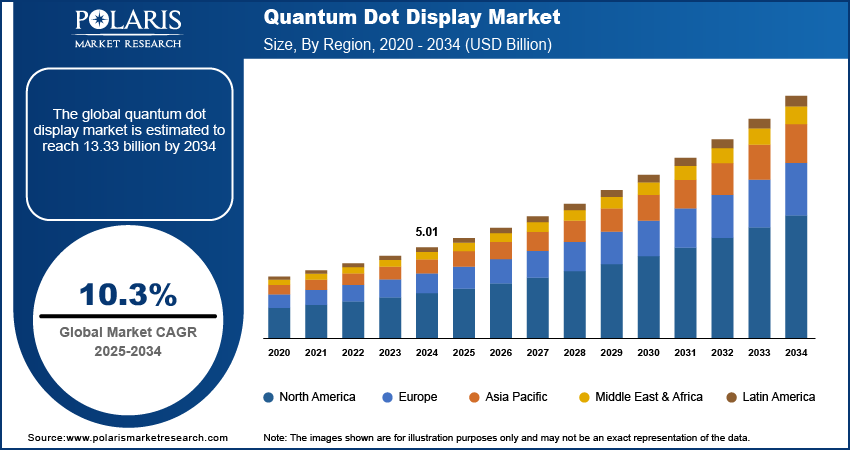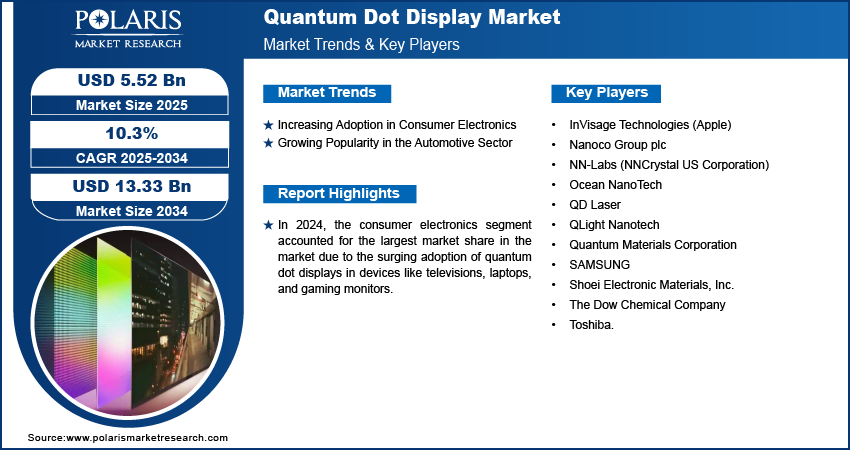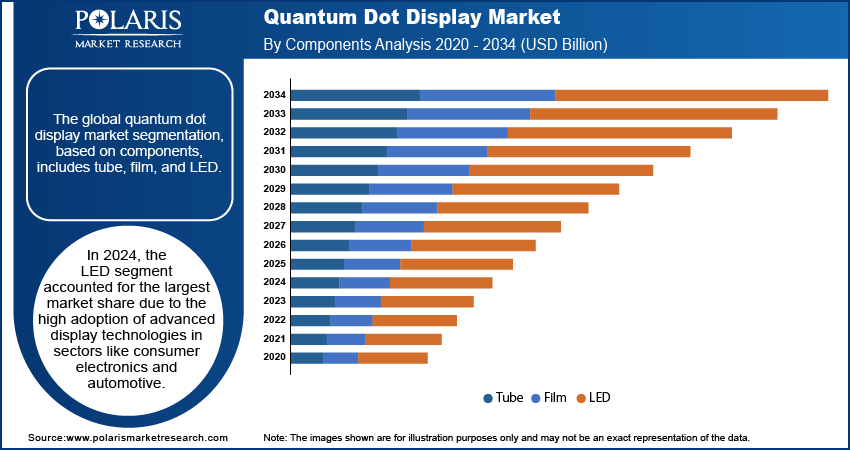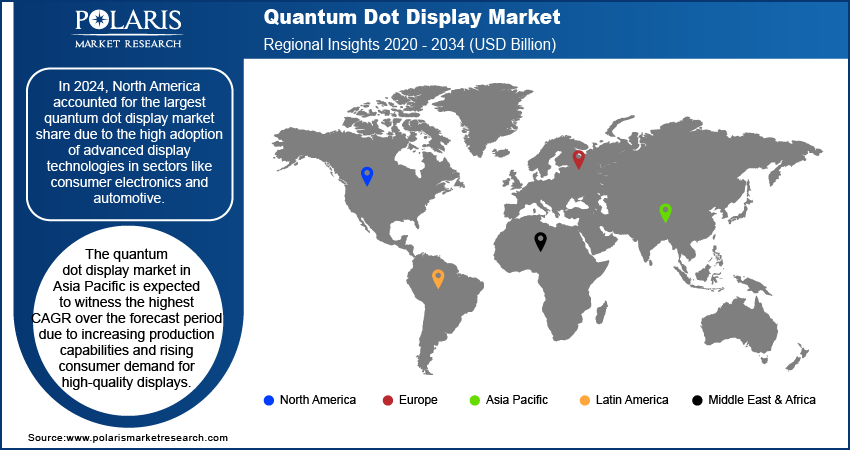
Quantum Dot Display Market Size, Share, Trends, Industry Analysis Report: By Component (Tube, Film, and LED), Material, Application, and Region (North America, Europe, Asia Pacific, Latin America, and Middle East & Africa) – Market Forecast, 2025-2034
- Published Date:Apr-2025
- Pages: 129
- Format: PDF
- Report ID: PM5461
- Base Year: 2024
- Historical Data: 2020-2023
Quantum Dot Display Market Overview
Quantum dot display market size was valued at USD 5.01 billion in 2024 and is expected to reach USD 5.52 billion by 2025 and 13.33 billion by 2034, exhibiting a CAGR of 10.3% during the forecast period.
The quantum dot display market refers to the industry focused on the development, production, and commercialization of display technologies. These technologies utilize quantum dots nanometer-sized semiconductor particles that emit precise, vivid colors when illuminated or electrically stimulated. Quantum dot displays are used in a range of devices such as televisions, monitors, and smartphones due to their ability to enhance brightness, color accuracy, and energy efficiency compared to traditional display technologies.
The growing consumer preference for ultra-high-definition (UHD) and 8K displays in televisions, monitors, and gaming devices is significantly contributing to the quantum dot display market growth. Quantum dot technology's ability to deliver superior color accuracy, brightness, and energy efficiency compared to conventional LCD and OLED displays further fuels demand. Additionally, the rise of smart home ecosystems and increasing adoption of smart TVs, smartwatches, and IoT-enabled displays are contributing to the market's rapid growth.

To Understand More About this Research: Request a Free Sample Report
Technological advancements in nanotechnology are enhancing the performance, durability, and cost-effectiveness of quantum dot displays. Research into quantum dot enhancement films (QDEF) and quantum dot color filters (QDCF) is improving color reproduction, peak brightness, and energy efficiency while reducing burn-in risks. These innovations are particularly appealing for applications in consumer electronics, automotive displays, and medical imaging. Furthermore, the growing adoption of smart TVs, smartwatches, and IoT-enabled displays is significantly boosting the demand for quantum dot display technology. These devices require high-resolution, energy-efficient displays with superior color accuracy to meet consumer expectations for immersive experiences. Quantum dots enhance display performance by providing vibrant colors, deeper blacks, and better brightness levels, which are critical for smart devices.
Quantum Dot Display Market Dynamics
Increasing Adoption in Consumer Electronics
The increasing integration of quantum dot technology into premium consumer electronics, such as smartphones, laptops, and tablets, is significantly contributing to the quantum dot display market expansion. For instance, according to Pew Research, about nine-in-ten Americans, which is equivalent to 91 percent, own a smartphone. This trend is driven by consumer demand for devices offering superior color accuracy, brightness, and energy efficiency, attributes enhanced by quantum dot displays. Moreover, manufacturers use quantum dot technology to differentiate their products in a competitive market, which is expanding the market and increasing its value. This surge in adoption is enhancing the visual experience for consumers and thereby propelling the market, as evidenced by the growing presence of these technologies in the latest consumer electronic devices.
Growing Popularity in Automotive Sector
The growing popularity of advanced in-vehicle displays, especially in luxury and electric vehicles, is significantly contributing to the quantum dot display market growth. For instance, Hyundai Mobis has developed an advanced vehicle display that combines Quantum Dot and Local Dimming technologies. Consumers increasingly demand high-quality visual interfaces for navigation, entertainment, and vehicle information systems, driving manufacturers to integrate advanced display technologies. The shift towards electric and autonomous vehicles further amplifies this demand, as these platforms often feature advanced infotainment systems, thereby creating substantial market opportunities for quantum dot display technologies.

Quantum Dot Display Market Segment Insights
Quantum Dot Display Market Assessment by Component
The global quantum dot display market segmentation, based on component, includes tube, film, and LED. In 2024, the LED segment accounted for the largest quantum dot display market share due to its superior efficiency, enhanced color accuracy, and widespread adoption in high-performance display technologies. Quantum dot-enabled LEDs offer a broader color gamut, improved brightness levels, and higher energy efficiency compared to conventional display technologies. Furthermore, the rising adoption of quantum dot LEDs in premium televisions, monitors, and advanced display panels is driving market expansion. Continuous advancements in LED integration with quantum dot technology, along with growing consumer preference for ultra-high-definition displays, have propelled quantum dot display market growth in this segment.
Quantum Dot Display Market Evaluation by Application Outlook
The global quantum dot display market is segmented by application into consumer electronics, healthcare, and others. In 2024, the consumer electronics segment accounted for the largest market share due to the surging adoption of quantum dot displays in devices such as televisions, laptops, and gaming monitors. The ability of quantum dots to deliver vibrant colors and enhanced viewing experiences aligns with consumer preferences for high-performance electronics. The increasing penetration of ultra-high-definition content and the rising trend of smart home ecosystems are boosting market dynamics. Moreover, the rapid pace of innovation in display technologies, coupled with declining production costs, has widened the adoption of quantum dots in mainstream electronics, contributing significantly to market growth.

Quantum Dot Display Market Share by Regional Analysis
By region, the study provides quantum dot display market insights into North America, Europe, Asia Pacific, Latin America, and the Middle East & Africa. In 2024, North America accounted for the largest market share due to the high adoption of advanced display technologies in sectors such as consumer electronics and automotive. The growing adoption of electric vehicles is fueling the demand for quantum dot displays, as these vehicles increasingly incorporate advanced, high-quality visual systems that enhance user experience with vibrant and precise color representation. For instance, according to the US Energy Information Administration, US sales of hybrid, plug-in hybrid, and battery electric vehicles increased from 17.8% to 18.7% of total light-duty vehicle sales between 1Q24 and 2Q24. The region's well-established technology infrastructure, coupled with significant investments in research and development, has accelerated the integration of quantum dot displays in high-end devices. Moreover, the rising demand for energy-efficient and environmentally friendly display solutions, driven by stringent regulatory standards, has further boosted market growth. The presence of major manufacturers and strong consumer demand for premium display products also contribute to the market expansion in this region.
The quantum dot display market in Asia Pacific is expected to witness the highest CAGR over the forecast period due to increasing production capabilities and rising consumer demand for high-quality displays. Rapid urbanization and a growing middle-class population with higher disposable incomes are fueling the adoption of quantum dot technology in devices such as televisions, smartphones, and laptops. Additionally, the region's dominance in electronics manufacturing, particularly in countries including China, South Korea, and Japan, is accelerating market dynamics. For instance, in January 2025, Samsung, the Korean company has advanced screen experiences for Filipino homes and businesses with its Real QLED TVs, utilizing advanced quantum dot technology to deliver superior color accuracy and brightness for immersive visual performance. Government initiatives supporting innovation and investments in advanced technologies further present significant opportunities for market growth in Asia Pacific.

Quantum Dot Display Key Market Players & Competitive Analysis Report
The competitive landscape of the quantum dot display market is characterized by the presence of several prominent players striving to innovate and expand their market share. Companies are focusing on strategic partnerships, acquisitions, and advanced product launches to strengthen their positions. Key players such as Samsung Electronics, LG Display, and TCL Corporation are investing significantly in research and development to improve the efficiency, brightness, and energy consumption of quantum dot displays. Additionally, the growing collaboration between display manufacturers and quantum dot material providers such as Nanosys and Nanoco Technologies is fostering technological advancements. The market is also witnessing competition through eco-friendly innovations, addressing increasing regulatory demands for sustainability. Furthermore, with the rising adoption of quantum dot technology across consumer electronics, automotive, and healthcare, companies are diversifying their portfolios to cater to evolving market demands, creating a highly dynamic and competitive environment globally.
Samsung Electronics Co., Ltd. is a South Korean multinational electronics company and a flagship subsidiary of the Samsung Group, headquartered in Suwon. Established in 1969, the company operates in the manufacturing of consumer electronics, semiconductors, and telecommunications equipment. Samsung's diverse product portfolio includes smartphones, televisions, home appliances, and various electronic components such as memory chips and displays. Samsung is a developer of quantum dot display technology, featured in its QLED TV lineup. This technology utilizes semiconductor nanoparticles to enhance color accuracy and brightness, allowing for the production of over a billion shades of color, which results in vivid and lifelike images. Samsung has set new standards in display quality, offering consumers superior viewing experiences while ensuring durability and environmental safety through the use of cadmium-free materials.
Toshiba Digital Solutions provides IT services for the manufacturing industry. The company was founded in 2003 and is based in Kanagawa, Japan. Toshiba Digital Solutions' service portfolio includes IoT services for the manufacturing industry, GridDB, factory IoT platform, and distributed co-simulation platform. The company utilizes IoT, artificial intelligence, and other digital technologies, as well as work in quantum technologies to support global business development. Toshiba is significantly advancing its presence in the quantum dot display with the launch of its QA4C and QL4C TV series, which utilize Quantum Dot Colour technology to enhance color accuracy and image quality. These TVs are designed to deliver up to one billion true-to-life colors, providing an immersive viewing experience that captures vibrant and realistic imagery.
Key Companies in Quantum Dot Display Market
- InVisage Technologies (Apple)
- Nanoco Group plc
- NN-Labs (NNCrystal US Corporation)
- Ocean NanoTech
- QD Laser
- QLight Nanotech
- Quantum Materials Corporation
- SAMSUNG
- Shoei Electronic Materials, Inc.
- The Dow Chemical Company
- Toshiba
Quantum Dot Display Market Developments
May 2024: Samsung Display, the OLED manufacturer, launched several innovative technologies at the SID 2024 event, including a glasses-free 3D OLED panel, the first QD-LED panel, an OLED display for XR headsets, and Ultra-Thin OLED panels, enhancing flexibility and performance.
September 2023: Shoei Chemical, Inc., completed an asset purchase agreement with Nanosys, Inc. This agreement allows Shoei, along with its North American subsidiary, to acquire nearly all assets related to Nanosys's quantum dot business, strengthening its position in the quantum dot technology sector.
May 2023: Nanoco Technologies Limited and Guangdong Poly Optoelectronics Co., Ltd. entered a Licensing and Collaboration Agreement to develop cadmium-free quantum dot technologies. This partnership aims to produce advanced materials for high-performance displays and lighting films, focusing on efficiency and environmental compliance.
Quantum Dot Display Market Segmentation
By Component Outlook (Revenue USD Billion 2020 - 2034)
- Tube
- Film
- LED
By Material Outlook (Revenue USD Billion 2020 - 2034)
- Cadmium Containing
- Cadmium-free
By Application Outlook (Revenue USD Billion 2020 - 2034)
- Consumer Electronics
- Healthcare
- Others
By Regional Outlook (Revenue USD Billion 2020 - 2034)
- North America
- US
- Canada
- Europe
- Germany
- France
- UK
- Italy
- Spain
- Netherlands
- Russia
- Rest of Europe
- Asia Pacific
- China
- Japan
- India
- Malaysia
- South Korea
- Indonesia
- Australia
- Vietnam
- Rest of Asia Pacific
- Middle East & Africa
- Saudi Arabia
- UAE
- Israel
- South Africa
- Rest of Middle East & Africa
- Latin America
- Mexico
- Brazil
- Argentina
- Rest of Latin America
Quantum Dot Display Market Report Scope
|
Report Attributes |
Details |
|
Market Size Value in 2024 |
USD 5.01 billion |
|
Market Size Value in 2025 |
USD 5.52 billion |
|
Revenue Forecast in 2034 |
USD 13.33 billion |
|
CAGR |
10.3% from 2025 to 2034 |
|
Base Year |
2024 |
|
Historical Data |
2020– 2023 |
|
Forecast Period |
2025 – 2034 |
|
Quantitative Units |
Revenue in USD Billion and CAGR from 2025 to 2034 |
|
Report Coverage |
Revenue Forecast, Market Competitive Landscape, Growth Factors, and Industry Trends |
|
Segments Covered |
|
|
Regional Scope |
|
|
Competitive Landscape |
|
|
Report Format |
|
|
Customization |
Report customization as per your requirements with respect to countries, regions, and segmentation. |
FAQ's
The global quantum dot display market size was valued at USD 5.01 billion in 2024 and is projected to grow to USD 13.33 billion by 2034.
The global market is projected to register a CAGR of 10.3% during the forecast period.
In 2024, North America accounted for the largest quantum dot display market share due to the high adoption of advanced display technologies in sectors such as consumer electronics and automotive.
Some of the key players in the market are InVisage Technologies (Apple); Nanoco Group plc; NN-Labs (NNCrystal US Corporation); Ocean NanoTech; QD Laser; QLight Nanotech; Quantum Materials Corporation; SAMSUNG; Shoei Electronic Materials, Inc.; The Dow Chemical Company; and Toshiba.
In 2024, the LED segment accounted for the largest market share due to the high adoption of advanced display technologies in sectors like consumer electronics and automotive.
In 2024, the consumer electronics segment accounted for the largest market share due to the surging adoption of quantum dot displays in devices like televisions, laptops, and gaming monitors.
